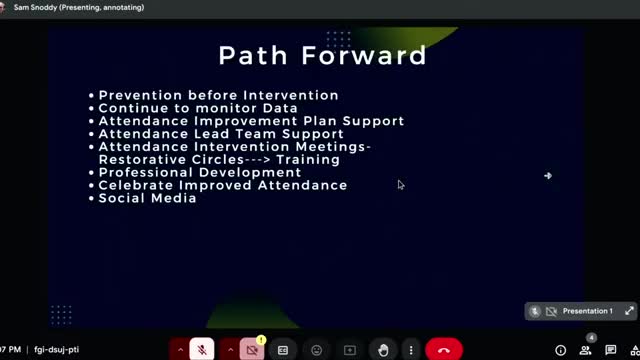Attendance Initiative Shifts Focus from Punishment to Prevention
November 17, 2024 | GADSDEN INDEPENDENT SCHOOLS, School Districts, New Mexico
This article was created by AI summarizing key points discussed. AI makes mistakes, so for full details and context, please refer to the video of the full meeting. Please report any errors so we can fix them. Report an error »

In a recent government meeting, officials outlined a strategic shift towards prioritizing prevention in student attendance initiatives, moving away from a reactive intervention model. The focus is now on fostering relationships and intrinsic motivation among students rather than relying solely on punitive measures.
The district has established an Attendance Lead Team, comprising administrators, teachers, and counselors, to guide campuses in implementing attendance improvement plans. A key innovation discussed is the integration of restorative circles into attendance intervention meetings, aimed at enhancing communication and support for students.
Training sessions led by mental health professionals are ongoing, emphasizing the importance of building connections within the school community. The district has also participated in professional development opportunities, including a recent attendance conference funded by an attendance grant. This funding is intended to support initiatives that celebrate improved attendance rather than merely rewarding perfect attendance.
A significant point of discussion was the current status of Juvenile Probation Officers (JPOs) under the Attendance for Success Act, which has limited their authority in handling truancy cases. Officials noted that, unlike previous years, there have been no JPO referrals this school year, raising concerns about the effectiveness of the current system. The conversation highlighted the need for legislative changes to empower JPOs and enhance their role in addressing juvenile crime and truancy.
The meeting also addressed the importance of clear communication with parents regarding attendance policies. Officials acknowledged the confusion surrounding the impact of excused versus unexcused absences on chronic absenteeism and emphasized the necessity of documenting all absences, even when they are excused.
As the district prepares for a more comprehensive presentation in December, officials expressed optimism about the ongoing collaboration with state agencies and community partners to improve attendance rates and support students effectively. The overarching goal remains to create a positive environment that encourages consistent school attendance and academic success.
The district has established an Attendance Lead Team, comprising administrators, teachers, and counselors, to guide campuses in implementing attendance improvement plans. A key innovation discussed is the integration of restorative circles into attendance intervention meetings, aimed at enhancing communication and support for students.
Training sessions led by mental health professionals are ongoing, emphasizing the importance of building connections within the school community. The district has also participated in professional development opportunities, including a recent attendance conference funded by an attendance grant. This funding is intended to support initiatives that celebrate improved attendance rather than merely rewarding perfect attendance.
A significant point of discussion was the current status of Juvenile Probation Officers (JPOs) under the Attendance for Success Act, which has limited their authority in handling truancy cases. Officials noted that, unlike previous years, there have been no JPO referrals this school year, raising concerns about the effectiveness of the current system. The conversation highlighted the need for legislative changes to empower JPOs and enhance their role in addressing juvenile crime and truancy.
The meeting also addressed the importance of clear communication with parents regarding attendance policies. Officials acknowledged the confusion surrounding the impact of excused versus unexcused absences on chronic absenteeism and emphasized the necessity of documenting all absences, even when they are excused.
As the district prepares for a more comprehensive presentation in December, officials expressed optimism about the ongoing collaboration with state agencies and community partners to improve attendance rates and support students effectively. The overarching goal remains to create a positive environment that encourages consistent school attendance and academic success.
View full meeting
This article is based on a recent meeting—watch the full video and explore the complete transcript for deeper insights into the discussion.
View full meeting
